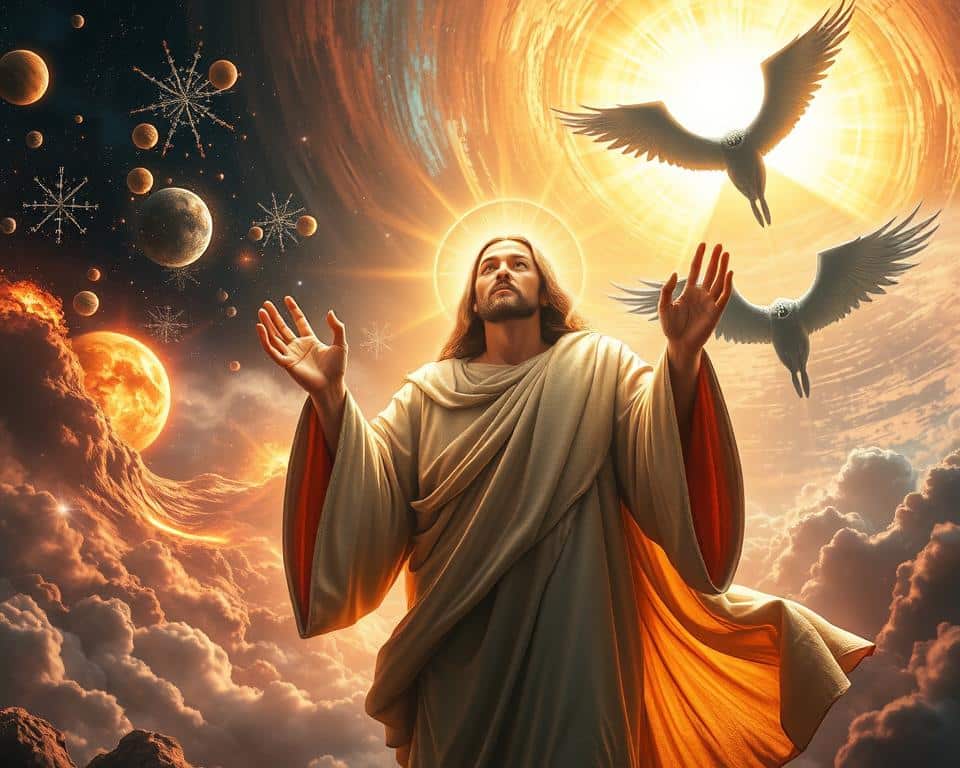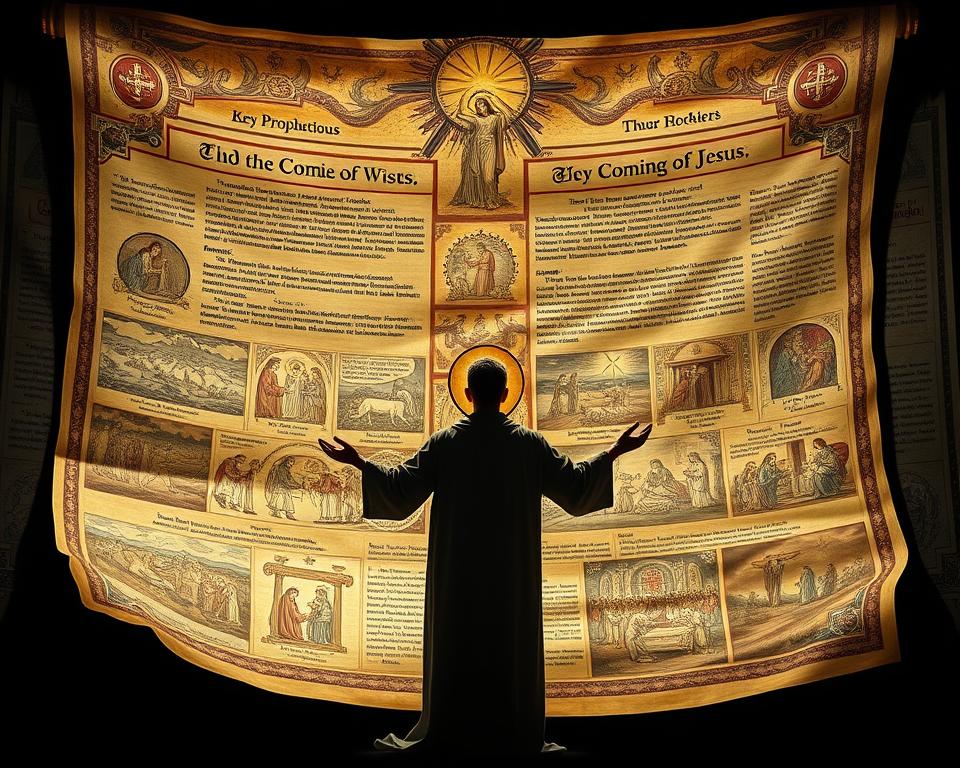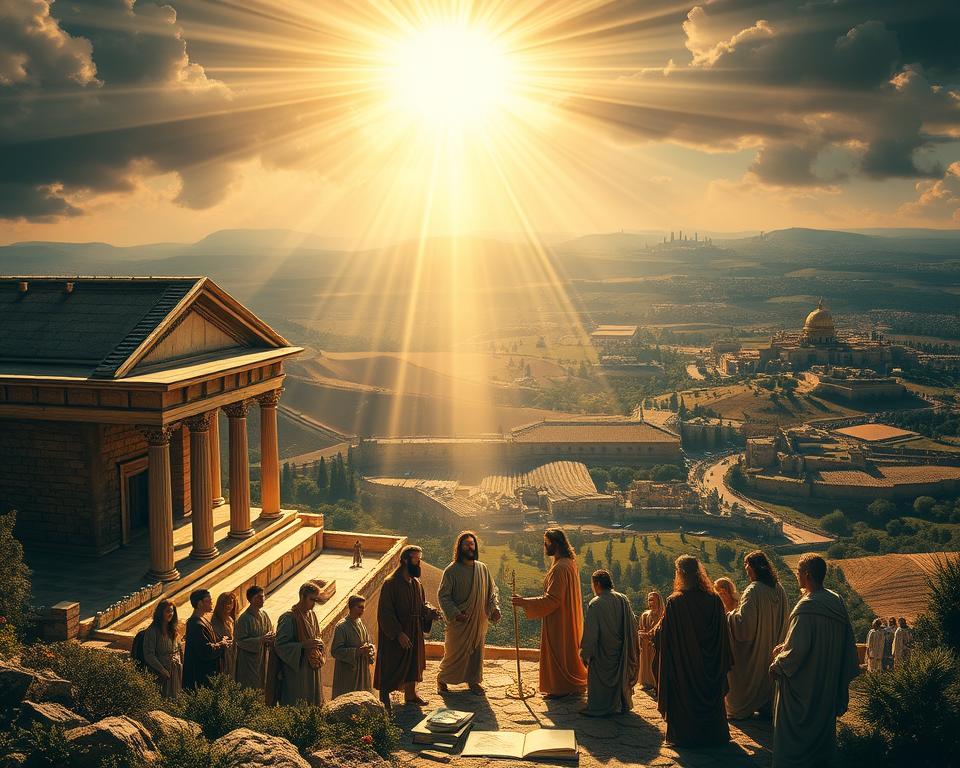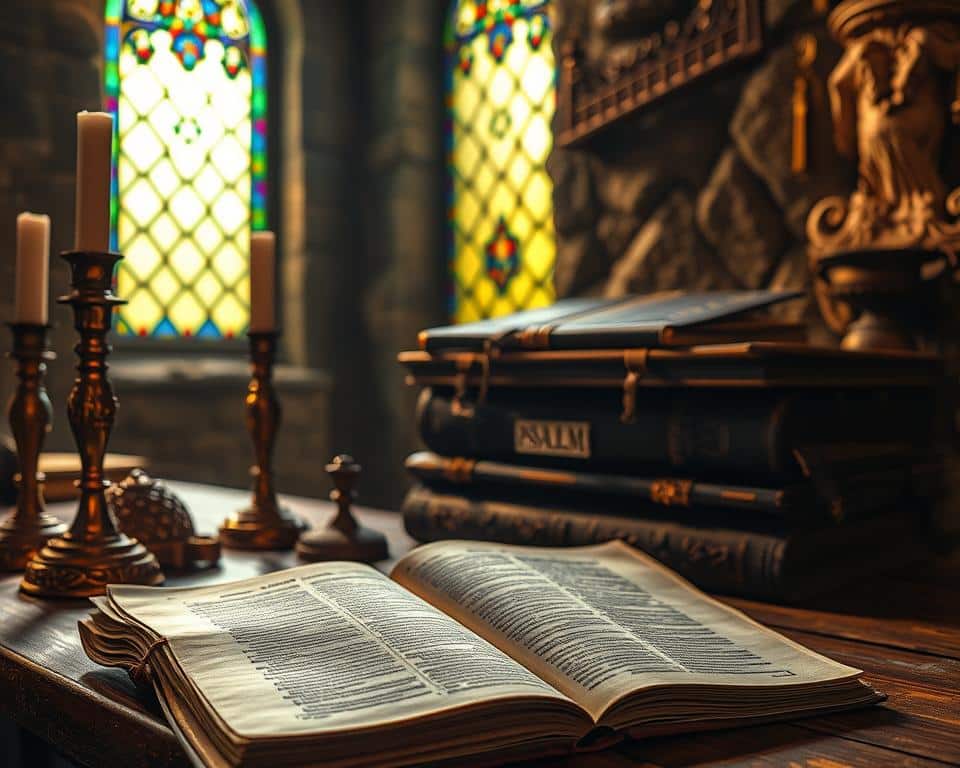Have you ever wondered what the final book of the Bible truly means? John’s vision in Revelation offers a powerful message of hope, especially for those facing trials. Written during intense persecution, this divine revelation assures believers of Christ’s ultimate victory.
This guide will help you uncover the deeper meaning behind the symbols while staying true to Scripture. Whether you’re seeking clarity or encouragement, these truths remain relevant today. Discover how faith and perseverance shine through even the darkest events.
Let’s explore God’s word together—unpacking prophecy, promise, and the way forward for every believer.
Introduction to John’s Vision in Revelation
Why did a persecuted disciple write such vivid words of prophecy? The answer lies in faith tested by fire. This book emerged from exile, offering hope to early believers under Rome’s tyranny.
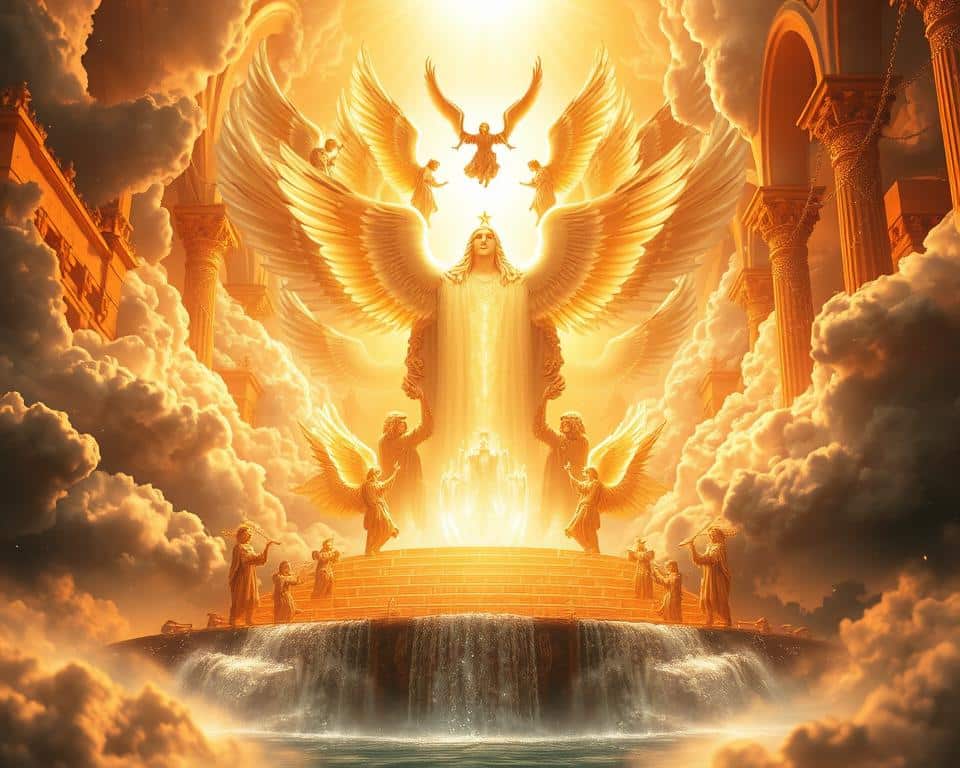
Who Was the Author Behind Revelation?
A close follower of Jesus, the writer witnessed His ministry firsthand. Banished to Patmos for his faith, he penned these words to seven struggling churches. His credibility anchors the visions in divine truth.
The Purpose of These Prophetic Visions
More than cryptic symbols, the book had a dual mission. It warned against compromise while comforting the faithful. Jesus’ presence dominates every scene, reminding readers of His ultimate victory.
Unlike a timeline, the visions repeat themes across cycles. This structure emphasizes God’s sovereignty over time. For the early church, it was a lifeline—and for us, a promise.
The Throne Room Vision (Revelation 4)
What does a glimpse into heaven reveal about God’s eternal plan? Revelation 4 pulls back the curtain, showing a throne surrounded by worship. This scene isn’t just awe-inspiring—it’s packed with meaning for your faith today.
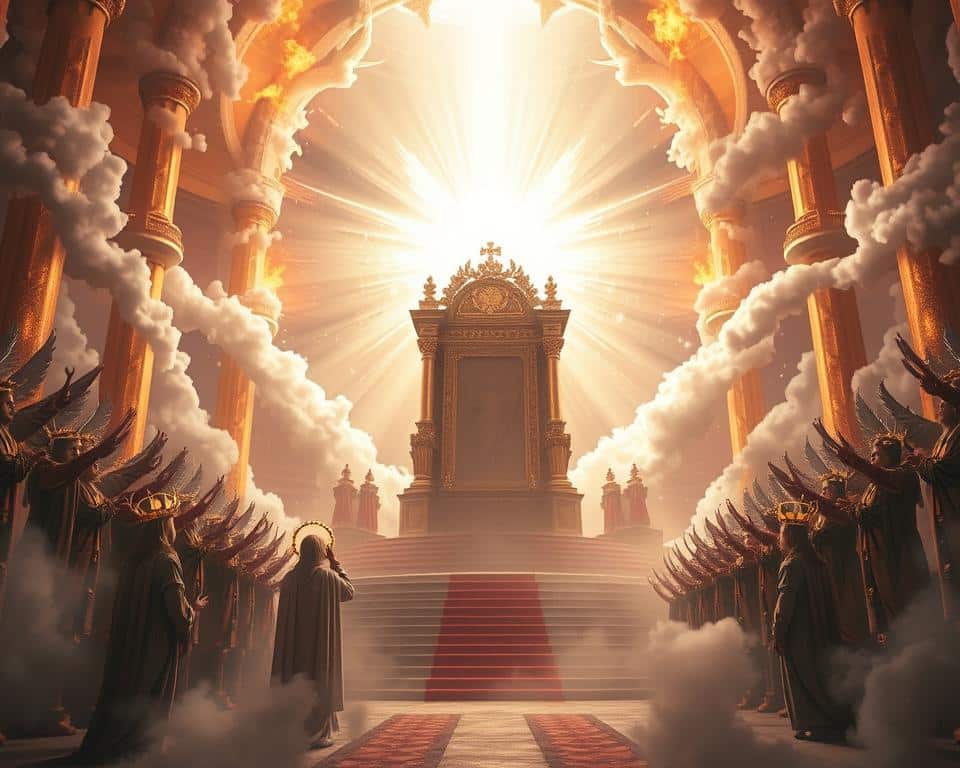
God’s Throne and Its Symbolism
The central throne shines with jewels: jasper (sacred presence) and sardius (judgment). An emerald rainbow arches overhead, echoing God’s covenant mercy. Below, a crystal sea reflects the Red Sea’s deliverance—a reminder of His saving power.
Thunder and lightning recall Exodus 19, where God revealed His holiness. Here, He reigns over heaven earth, unshaken by chaos. Every detail points to His authority and grace.
The Four Living Creatures and 24 Elders
Around the throne, four creatures embody creation’s praise: lion (strength), ox (service), man (intelligence), and eagle (swiftness). They never stop worshiping, declaring God’s holiness day and night.
Twenty-four elders—representing Israel’s tribes and Christ’s apostles—cast their crowns before Him. Their unity symbolizes all believers, past and present, honoring the King. Together, they show worship isn’t ritual—it’s surrender.
“Holy, holy, holy is the Lord God Almighty, who was and is and is to come!” (Revelation 4:8).
This room isn’t distant. It’s a promise: one day, you’ll join this unending song. Until then, let it fuel your hope and praise.
The Scroll and the Lamb (Revelation 5)
What holds the key to humanity’s future according to Scripture? In Revelation 5, a sealed scroll rests in God’s hand, containing His redemptive plan. No one in heaven or earth is worthy to open it—until the Lamb steps forward.
The Sealed Scroll and Its Meaning
This scroll mirrors a title deed, like those in Old Testament times (Ezekiel 2:9–10). Its seven seals represent the complete unfolding of God’s justice and mercy. To break them is to reclaim creation from sin’s grip.
John weeps when no one is found worthy—until elders point to Christ. The Lion of Judah (a conqueror) appears as a slain Lamb (a sacrifice). This duality shows His victory through surrender.
Why Only the Lamb Could Open the Scroll
The Lamb’s seven horns symbolize perfect power; His seven eyes signify the Holy Spirit’s wisdom (Revelation 5:6). His wounds prove His authority to judge and redeem.
- Worship responds: Elders play harps (praise) and hold golden bowls (prayers).
- Global promise: Every tribe and nation will worship—fulfilling the Great Commission.
“Worthy is the Lamb who was slain, to receive power and wealth and wisdom and might!” (Revelation 5:12).
This scene isn’t just prophecy. It’s an invitation. The Lamb’s triumph assures you that evil’s defeat is certain—and your faith is never wasted.
The Seven Seals (Revelation 6)
What unfolds when the Lamb begins opening the seven seals? Revelation 6 reveals a sequence of divine actions—each a response to human history’s brokenness. These events aren’t random; they reflect God’s authority over earth and His care for His people.
The Four Horsemen and Their Significance
The first four seals unleash symbolic riders. A white horse signifies false peace (conquest), red brings violence, black announces scarcity, and pale green heralds death. Together, they depict cycles of human suffering under judgment.
Yet, God limits their power. The horsemen ride only as He permits—a reminder that evil never spirals beyond His control.
The Cry of the Martyrs
Under the fifth seal, martyrs ask, “How long?” (Revelation 6:10). Their white robes symbolize Christ’s righteousness covering them. God’s reply—“Wait a little longer”—shows His patience, ensuring more people join His family.
The sixth seal echoes Joel 2:31: skies darken, mountains shake. Rulers and others panic, but believers recognize these as signs of Christ’s return. Even chaos points to His victory.
“The great day of their wrath has come, and who can stand?” (Revelation 6:17).
This chapter isn’t about fear. It’s a call to trust the One who holds the scroll—and your future.
The 144,000 and the Great Multitude (Revelation 7)
How does God mark His faithful followers in the last days? Revelation 7 unveils two awe-inspiring groups—the 144,000 and a vast multitude. Together, they symbolize God’s unshakable promise to guard and redeem His people.
Who Are the 144,000?
This numbered group—12,000 from each tribe of Israel—represents completeness (12×12×1,000). Scholars debate whether it’s literal or symbolic. The new testament suggests it’s spiritual Israel (Galatians 6:16), encompassing all who follow Christ.
Their “sealing” mirrors the Holy Spirit’s mark in Ephesians 1:13. It’s not a physical stamp but God’s guarantee of protection amid trials. Like the seven churches, they’re called to stand firm.
The Promise of Protection for God’s People
The second group—a countless multitude—shows God’s grace extends beyond Israel. Clothed in white, they wave palm branches, echoing the Feast of Tabernacles (Leviticus 23:40). Their joy celebrates final deliverance.
- Eternal security: “Never again will they hunger or thirst” (Revelation 7:16).
- Global hope: Every nation, tribe, and tongue joins this redeemed family.
“Salvation belongs to our God, who sits on the throne, and to the Lamb!” (Revelation 7:10).
This vision isn’t just about the future. It’s a message for today: God sees your faithfulness. Your life in Christ is eternally secure.
The Seven Trumpets (Revelation 8–11)
What happens when divine warnings sound across the earth? The seven trumpets in Revelation 8–11 reveal God’s measured response to rebellion. Unlike final judgments (the bowls), these blasts offer chances to repent before Christ’s return.
Natural Disasters as Divine Judgment
The first four trumpets mirror Exodus plagues—hail, fire, and water turned bitter. A “third of earth” is affected (Revelation 8:7–12), showing God’s mercy even in judgment. These aren’t random events. They’re calls to turn back to Him.
The fifth trumpet unleashes demonic locusts (Revelation 9:1–11). Unlike Exodus’ insects, these torment without killing. Their king, “Abaddon,” means destruction. Yet, believers are sealed—safe in God’s care.
The Two Witnesses and Their Role
Amid chaos, two prophets arise (Revelation 11:3–6). Like Moses and Elijah, they wield power over plagues and fire. Their 1,260-day ministry matches Israel’s wilderness wanderings—a time of testing for the church.
Their deaths spark global celebration, but resurrection silences doubters. This pattern repeats Scripture’s truth: God’s messengers often face rejection before victory.
“Take and eat it; it will make your stomach bitter, but in your mouth it will be sweet as honey” (Revelation 10:9).
John’s scroll-eating experience reflects prophecy’s dual nature. God’s word is sweet to believers but bitter in its warnings. Even so, it always points to hope.
The Seven Bowls of Wrath (Revelation 15–16)
What marks the final stage of God’s judgment in Scripture? The seven bowls pour out His wrath on those who reject His truth. Unlike the seals and trumpets, this series brings complete destruction—a decisive end to evil.
The Final Plagues and Their Symbolism
Each bowl mirrors Exodus plagues but with greater intensity. Sores afflict the beast’s followers (Revelation 16:2), seas turn to blood, and darkness shrouds the earth. The language is symbolic, yet the message is clear: God’s patience has limits.
Demonic spirits, like frogs, deceive kings into one final battle (Revelation 16:13–14). The Euphrates dries up, removing barriers to conflict. These details reveal Satan’s last stand—and God’s sovereign control.
The Battle of Armageddon
“Armageddon” (Hebrew for Mount Megiddo) recalls ancient battlegrounds. Here, it symbolizes the climax of cosmic conflict. Christ returns not to fight but to triumph, His robe stained with atoning blood (Revelation 19:13).
“Behold, I am coming like a thief! Blessed is the one who stays awake” (Revelation 16:15).
- Seals, trumpets, bowls: A progression from warning to finality.
- Frog spirits: False miracles that lure the world to rebellion.
- Euphrates: A barrier removed, exposing humanity’s vulnerability.
This isn’t mere doom. It’s the prelude to Christ’s victory—and your hope if you stand with Him.
The Fall of Babylon and the New Jerusalem (Revelation 17–22)
Why does Revelation depict two cities—one doomed and one eternal? The answer reveals God’s ultimate victory over evil. Babylon’s fall and the new jerusalem’s rise frame the Bible’s grand story of redemption.
Babylon as a Symbol of Evil
Babylon’s purple and scarlet robes (Revelation 17:4) echo royal corruption. Like ancient Rome, it represents oppressive systems that defy God. The woman drunk on martyr blood contrasts sharply with the pure bride of Christ.
Her downfall is certain. The old testament warned of Babylon’s pride (Isaiah 47:8–10). Here, it’s fulfilled—a reminder that worldly power fades. God’s justice dismantles every evil structure.
The Vision of the New Heaven and Earth
The new jerusalem descends like a bride (Revelation 21:2). Its cube shape mirrors the Holy of Holies—now expanded for all believers. Twelve gates bear tribal names; twelve foundations honor apostles, uniting God’s covenant story.
- No temple needed: God’s immediate presence replaces rituals (Revelation 21:22).
- Eden restored: The tree of life heals nations (Revelation 22:2).
“Behold, I am making all things new” (Revelation 21:5).
This city needs no sun—God’s glory lights it. The Lamb’s throne stands at the center, inviting you to dwell where pain and death are gone forever.
What John’s Vision Means for Us Today
How can ancient prophecies guide your faith today? Like the seven churches, you’re called to stand firm. Ephesus resisted false teachings but lost its first love. Pergamum faced pressure yet held fast. Their struggles mirror ours—secular pressures, materialism, and persecution.
Modern “Babylon” lures with temporary wealth, but God’s truth endures. The martyrs’ faithfulness challenges us to prioritize Christ above all. Their words echo: “Hold fast” (Revelation 2:25). Discipleship isn’t passive—it’s active trust in His promises.
The sanctuary message points to the future. Just as the New Jerusalem descends, Christ’s return is certain. His pledge—“I am coming soon” (Revelation 22:20)—anchors our hope. For others and you, this truth transforms how we live today.

